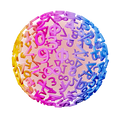Square Numbers, Cube Numbers, Triangular Numbers and Other Figurate Numbers
Here, you’ll learn about sequences where the terms don’t increase by the same amount. That means these sequences aren’t arithmetic sequences.
The secret to understanding these sequences is to be familiar with several common types. Below, we’ll give you an overview of some common sequences. Some of them are even arithmetic.
Theory
Important Sequences
-
Even numbers:
-
-
Odd numbers:
-
-
Exponentials:
-
-
The Fibonacci sequence:
-
1, 1, 2, 3, 5, 8, 13, 21, 34,
-
-
Even numbers:
-
-
Odd numbers:
-
-
Exponentials:
-
-
The Fibonacci sequence: 1, 1, 2, 3, 5, 8, 13, 21, 34,
Some sequences have names like the square numbers after the square, triangular numbers after the triangle, and so on. That’s because the numbers in these sequence create larger and larger squares and triangles, as you can see in the figures further down.
Example 1
Square Numbers
The sequence of square numbers,
is made up of squares of integers. A square is a number multiplied by itself.
, The first number of the sequence is the square of , which is .
, the second number if the sequence is the square of , which is .
, the third number if the sequence is the square of , which is .
, the fourth number if the sequence is the square of , which is .
, a random number in the sequence is the square of , which is .
Find the seventh term in the sequence. To do that, you just insert into the formula:
Example 2
Cube Numbers
The formula for the th term of the cube numbers is . The figure below show you how the sequence develops term by term:
Example 3
Rectangular Numbers
The sequence of rectangular numbers,
is made up of products of consecutive integers on the real line. This means that each number is the area of a rectangle that has sides equal to those two consecutive integers.
The area of a rectangle is its length multiplied by its width.
. The first number of the sequence is the area of the rectangle with sides equal to and .
. The second number of the sequence is the area of the rectangle with sides equal to and .
. The third number of the sequence is the area of the rectangle with sides equal to and .
. The fourth number of the sequence is the area of the rectangle with sides equal to and .
. The ’th term of the sequence is the area of the rectangle with sides equal to and .
In this rectangle, one of the sides is equal to . The other side of the rectangle is the integer after on the real line, which is . In the second figure, where , one side of the rectangle is equal to , and the other side is equal to .
To find the eight term of the sequence you insert into the formula and get
Example 4
Triangular Numbers
The sequence
is called “the triangular numbers”. The sequence is made up of half the area of a rectangle with sides equal to and . In the figure below, you can see rectangles where only half the spheres are filled up. The filled spheres show you the triangular numbers.
Let’s see what happens when we multiply the sides of the rectangle with each other and then divide the answer by :
The area of a rectangle with sides equal to consecutive integers is
When we divide this by , we get the area of the triangles. That gives you the formula
Find the sixth term of the sequence. You just insert into the formula and get .
When you get familiar with these sequences, you can use them to find formulas for more difficult sequences, like in this example:
Example 5
You can see the following figurate numbers:

After studying these you realize that they can be divided into two groups like this:

You can see that the figures are made up of a square number and a triangular number. As you now know these formulas, you can combine them to make a formula for this specific sequence:
























